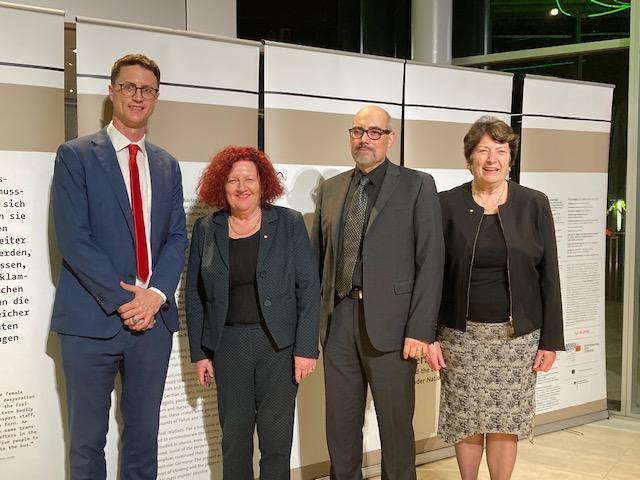More than 400,000 people living with psychiatric illnesses and intellectual and physical disabilities were forcibly sterilised – and more than 200,000 were murdered – in Germany and occupied territories between 1933 and 1945.
Doctors, nursing staff and functionaries passed judgement on each of their patients based their supposed “value”. The extermination of patients took place within the institutional and hospital systems.
An exhibition exploring the persecution and murder of hundreds of thousands of sick and disabled patients by medical practitioners and nurses in Nazi Germany has been brought to Brisbane by several academics from The University of Queensland.
This is the first time the exhibition, titled ‘Registered, persecuted, annihilated: the sick and disabled under National Socialism', has been staged in Queensland. It was originally commissioned by the German Association for Psychiatry, Psychotherapy and Psychosomatics, and curated by the Foundations Memorial to the Murdered Jews of Europe and Topography of Terror in Berlin.
Dr Darren O’Brien, President of the Australian Institute for Holocaust and Genocide Studies and Honorary Research Senior Fellow in UQ’s School of Historical and Philosophical Inquiry, secured a grant to bring the exhibition to Queensland for the first time as part of Australian Holocaust Awareness Week.
“I wanted to bring the exhibition to the wider public, especially to nursing and medicine audiences,” Dr O’Brien said.
“Doctors and nurses consistently globally rank as the most trusted professions. There is tremendous accountability that comes with such a profile.”
The exhibition contrasts the views of the perpetrators with those of their victims, as revealed by their files, and examines how such atrocities were able to take place.
The exhibition was on show at the Queensland Museum during Australian Holocaust Memorial Week from 3–7 May, and will relocate to the Royal Brisbane and Women’s Hospital Conference and Education Centre from 17–21 May.

An accompanying lecture and film program will take place next door to the exhibition in UQ’s Centre for Clinical Research auditorium throughout the week.
UQ Faculty of Medicine’s Professor Linda Shields and her son, Dr Kirril Shields of the UQ School of Political Science and International Studies, are in the leadership team for the exhibition.
Professor Linda Shields, also a registered nurse, said nursing as a profession had been blighted by the lack of historical examination and accountability for the actions of nurses in this period.
“The doctors decided who would be killed, and signed the forms, but it was largely nurses who did the killings,” she said.
“They used narcotics or overdoses of drugs such as phenobarbitone along with starvation and exposure to cold.”
“In some places, gas was used. These places were where the factory-style killing methods of the Final Solution were developed.”
Professor Shields said some nurses participated willingly, while others refused.
“Many had been influenced by Nazi Party propaganda infused with eugenic ‘race hygiene’ theory to believe that killing those of inferior race and intellect was the correct approach to ensure the preservation and continuity of the Aryan race,” she said.
“These nurses were either committed to what they thought was a correct procedure, or believed they had to obey the orders of others at all costs.”
Dr Kirril Shields, who works at the Asia-Pacific Centre for the Responsibility to Protect, said taking the exhibition to a wider audience was vital if the lessons of history were to be learned.
“One question we grapple with at the centre is, what is the best approach to preventing crimes of such magnitude? Foremost is education, and this is what's so important about this exhibition.”
“It provides people of all backgrounds insight into the terrible crimes committed by Germany's medical and nursing professions during Hitler's reign, and has us realise that these crimes are so easily committed by seemingly reputable and educated members of our communities.”
Register to attend



